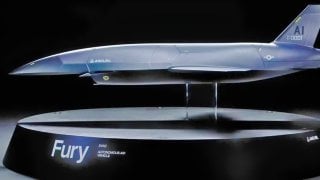Collaborative Combat Aircraft (CCA) Program: This Might Be the Air Force's Future
The U.S. Air Force is modernizing its fleet with the Next Generation Air Dominance (NGAD) stealth fighter and the Collaborative Combat Aircraft (CCA) drone program.
All You Need to Know: The U.S. Air Force is modernizing its fleet with the Next Generation Air Dominance (NGAD) stealth fighter and the Collaborative Combat Aircraft (CCA) drone program.
-The CCA drones will act as "wingmen" to the manned NGAD jets, providing kinetic options at a lower cost, with initial deliveries expected by the mid-2030s. Each CCA drone will cost around $30 million, significantly less than the projected $300 million per NGAD. Equipped with artificial intelligence but under human control, the CCAs will support air superiority missions and enhance combat capabilities.
-The Air Force has allocated $30 billion over the next five years to develop both programs.
Collaborative Combat Aircraft: The Air Force’s Game-Changing Drone Fleet
The U.S. Air Force is modernizing its fleet to meet the demands of tomorrow. As part of this modernization, the Air Force is investing in the Next Generation Air Dominance (NGAD) program that aims to produce America’s next air superiority stealth fighter jet.
At the same time, the Air Force is working on the Collaborative Combat Aircraft (CCA) program, which is looking to produce a fleet of deadly drones that can provide expanded fighter capability at a lower cost.
The Collaborative Combat Aircraft is designed to operate in conjunction with the NGAD and be used by the manned stealth fighter jet as a kinetic option against threats. Essentially a drone wingman, the CCA program will provide military planners with a cheaper and more expendable force in the skies. It will accompany next-generation aircraft and assist them in air superiority and other mission sets.
For example, in a future battlefield, a manned NGAD sixth-generation stealth fighter jet would go into battle accompanied by several CCAs. The NGAD pilot would use the sensors on board to detect threats and then guide the CCAs accordingly. The NGAD itself would be able to take on threats as well.
Overall, the Air Force is looking at an initial delivery of between 1,000 to 2,000 CCA drones by the middle of the next decade.
Air Force officials have occasionally spoken about the capabilities they want in the CCA and its development process. Recently, Air Force Secretary Frank Kendall gave some up-to-date information on the CCA and what capabilities the Air Force is looking for in the unmanned aerial system.
“One of the things you have to have if you’re going to use CCAs and have them be armed and used and lethal is that they have to be under tight control,” Kendall said.
“And for me, one of the elements of that needs to be line-of-sight communications. And I think that that’s an important thing to have in the mix: secure, reliable, line-of-sight communications,” the Air Force Secretary added.
The Collaborative Combat Aircraft will be using artificial intelligence. Yet, human control remains an important aspect of the program.
“We’re not going to have aircraft going out doing engagements uncontrolled, so the default, if they lose communications, would be for them to return to base, which takes them out of the fight, so we don’t want that to happen. And when they do do engagements, we want them under tight control,” Kendall stated.

The Air Force expects to award a contract for the NGAD in 2025, with Lockheed Martin competing with Boeing. The Air Force also expects to have an operational capability for the Collaborative Combat Aircraft in a similar timeline.
In April, the Air Force decided to continue funding General Atomics and Anduril for their different designs for the CCA competition. However, the Air Force is looking for a collaborative process that will produce a better result.
The rising costs of the NGAD program – estimates put the cost of each aircraft as high as $300 million per aircraft – are forcing the Air Force to consider moving some capabilities of the stealth fighter jet to the Collaborative Combat Aircraft. However, it is not yet clear what this transfer of capabilities will be and to what extent. After all, the drone is being designed to support the NGAD and not the other way around. Depending on the extent of the transfer, the whole concept of the NGAD could change.
The Air Force estimates that each CCA will cost in the range of $30 million – more than three times cheaper than an F-35 stealth fighter jet and up to 10 times cheaper than an NGAD under the current cost projections.
The service has set aside almost $30 billion over the next five years for the design and development of the NGAD and CCA.
About the Author
Greek Army veteran (National service with 575th Marines Battalion and Army HQ). Johns Hopkins University. You will usually find him on the top of a mountain admiring the view and wondering how he got there.
This article and hero image first appeared in Sandboxx.


